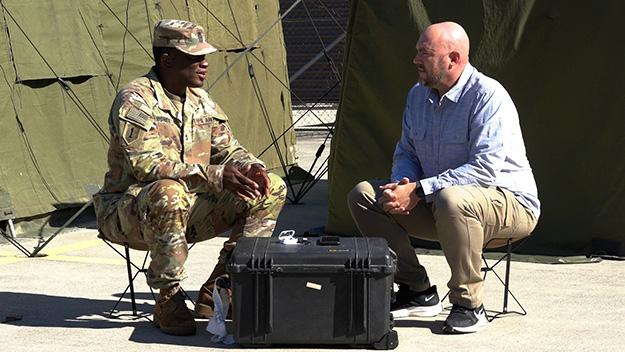BRISBANE, Australia - Technology by definition is the application of scientific knowledge for practical purposes, especially in industry.
With a force of more than 1.4 million service members, not including Reserve and National Guard component service members, Dr. Nathan Fisher says the U.S. Department of Defense is always looking years ahead for the advantage in the continually evolving, multi-trillion-dollar industry.
While significant amounts of U.S. military spending is allocated towards weapons platforms, a relatively small portion goes into the wellbeing of its most critical assets - U.S. soldiers, airmen, sailors, Marines, Coast Guardsmen and guardians, according to Fisher, a senior scientist with the Joint Program Executive Office for Chemical, Biological, Radiological and Nuclear Defense.
Currently, Fisher said that funding is being used to test new technology that could help DoD prevent heat-injuries among its service members, among other things. He said more than 12,000 U.S. service members experience heat injuries annually.
Fisher said various research and development organizations within the DoD are participating in a one year Wearables Pilot Program to gain insight on how to implement wearable bio-physiological monitoring devices into the military from a practical and architectural vantage point.
The wearables come in various forms, which in some cases are familiar as a smartwatch.
One of its latest devices made the thousands of miles journey from the U.S. to Australia to be tested on service members training as a part of Exercise Talisman Sabre 2023.
"What we have here is the Health Readiness and Performance System, which is one of the devices that we're evaluating as part of the wearables experiment (at) Talisman Sabre," Fisher said.
The piece of technology connects to a data strip on the skin over the heart, which is nearly the size of a standard bandage you'd have in a medicine cabinet.
Although it takes up a small amount of space on a service member who otherwise carries upwards of 60 pounds of gear, its capacity to save lives is enormous.
"This particular device can do a number of things, but one of many is to identify early signs of heat stress and heat illness," said Fisher, the native of Arlington, Virginia, who is also the rank of major in the U.S. Army Reserve.
The device connects to a cell phone through a receiver via secure communications technology.
"It measures heart rate, heart rate variation, respiratory rate, pulse oxygen level activity, and a few other physiological metrics that all come together in order to enable a predictive algorithm to analyze the data from that service member and then alarm that individual, or squad leader, or medic to take a look at that person," Fisher continued.
A squad leader in the immediate area, or a medic receiving the information via a server, can receive the data to make an informed potential life-saving decision.
According to Fisher, the device ideally takes two days to establish a baseline reading of an individual's data.
He said information derived from a collection of individuals' data can also lead to preventive medicine measures amongst a formation including the spread of communicable diseases and viruses.
Wearables have commanded the attention of senior leaders supporting Talisman Sabre.
"I don't get too excited about technology but this device is lifesaving," said U.S. Army Col. Kevin Bass, the deputy commanding officer of 18th Medical Command, which is part of the Australian Defence Force and U.S. Combined Joint Theater Medical Component in supporting Talisman Sabre.
While reflecting on his service with the "Screaming Eagles" of the 101st Airborne Division (Air Assault), he noted how a small percentage of paratroopers were expected to receive varying degrees of injuries on a given jump.
"Imagine if the medical guy sitting at the lead edge of the drop zone had an app," Bass said. "You can sit there and scroll through it, and maybe in a future version of this, you can automatically race to the ones with an alert status."
Currently, more than 500 service members across the Australian continent are testing the wearable technology.
The Combined Joint Theater Medical Component coordinates and synchronizes health service and support across the Australian continent, which is nearly the size of the mainland of the U.S.
Talisman Sabre is the largest bilateral military exercise between Australia and the United States advancing a free and open Indo-Pacific by strengthening relationships and interoperability among key allies and enhancing our collective capabilities to respond to a wide array of potential security concerns.





Read Comments